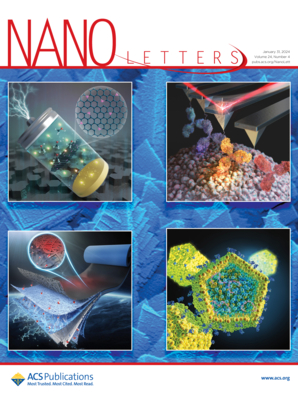High-Entropy Spinel Oxide Nanostructures as Stable Cathodes for Solid Oxide Fuel Cells
IF 9.6
1区 材料科学
Q1 CHEMISTRY, MULTIDISCIPLINARY
引用次数: 0
Abstract
Solid oxide fuel cells (SOFCs) represent a promising clean energy technology for efficient chemical-to-electrical energy conversion with minimal environmental impact. However, the development of cathode materials that can maintain both high performance and long-term stability remains challenging, particularly due to the degradation of nanostructured cathodes caused by particle coarsening. This study employs an impregnation method to fabricate high-entropy spinel oxide (Mg0.2Fe0.2Co0.2Ni0.2Cu0.2)Fe2O4 (MFCNCF) nanoparticles with varying loadings on a porous Ce0.9Gd0.1O1.95 (GDC) skeleton. The optimized cathode with 30 wt % MFCNCF loading achieves a remarkably low polarization resistance of 0.12 Ω·cm2 and maximum power density of 1063.94 mW·cm–2 at 800 °C. Most significantly, the entropy stabilization effect enables the high-entropy spinel oxide nanoparticles to maintain their microstructure throughout 240 h of operation with negligible performance degradation. The study introduces a novel strategy combining high-entropy design with nanostructure engineering to develop stable and high-performance cathode materials for SOFCs.

求助全文
约1分钟内获得全文
求助全文
来源期刊

Nano Letters
工程技术-材料科学:综合
CiteScore
16.80
自引率
2.80%
发文量
1182
审稿时长
1.4 months
期刊介绍:
Nano Letters serves as a dynamic platform for promptly disseminating original results in fundamental, applied, and emerging research across all facets of nanoscience and nanotechnology. A pivotal criterion for inclusion within Nano Letters is the convergence of at least two different areas or disciplines, ensuring a rich interdisciplinary scope. The journal is dedicated to fostering exploration in diverse areas, including:
- Experimental and theoretical findings on physical, chemical, and biological phenomena at the nanoscale
- Synthesis, characterization, and processing of organic, inorganic, polymer, and hybrid nanomaterials through physical, chemical, and biological methodologies
- Modeling and simulation of synthetic, assembly, and interaction processes
- Realization of integrated nanostructures and nano-engineered devices exhibiting advanced performance
- Applications of nanoscale materials in living and environmental systems
Nano Letters is committed to advancing and showcasing groundbreaking research that intersects various domains, fostering innovation and collaboration in the ever-evolving field of nanoscience and nanotechnology.
 求助内容:
求助内容: 应助结果提醒方式:
应助结果提醒方式:


